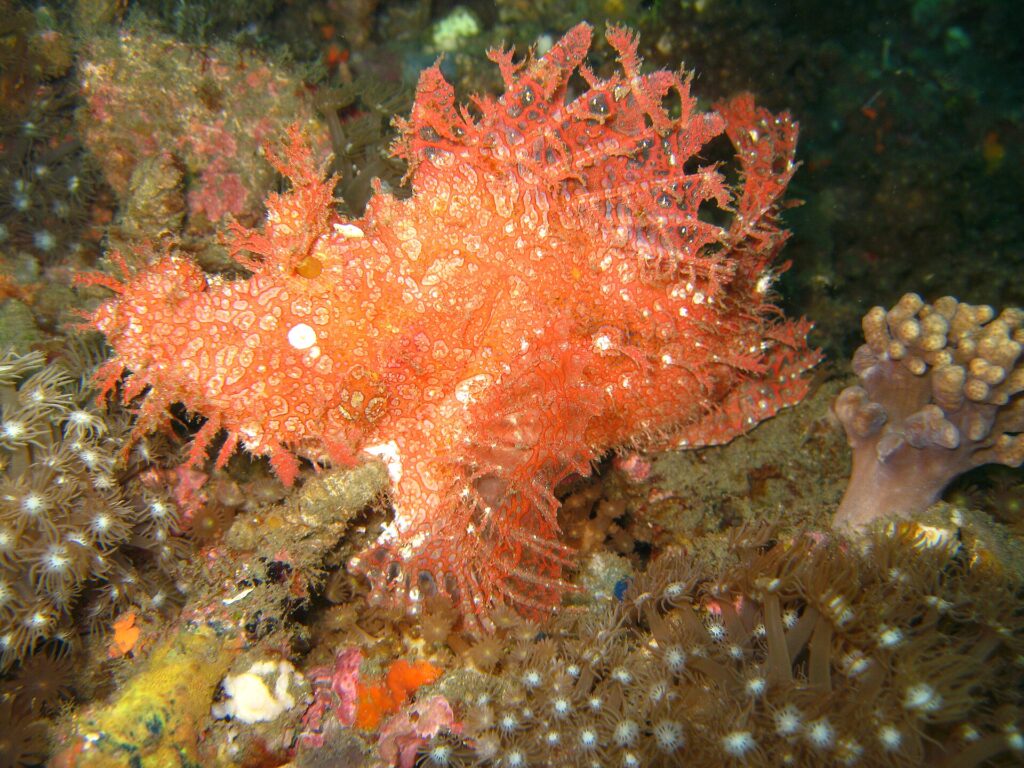Weedy scorpionfish, also known as Rhinopias frondosa, is a slow-moving predator that’s almost too unique to be real. This rare member of the scorpionfish family is notoriously hard to spot unless you’re diving the volcanic black sands of Lembeh Strait, where they’re more commonly encountered.
But here’s the twist: this fish doesn’t want to be found. Its entire survival strategy is to hide and vanish into its surroundings. In this guide, we break down why it camouflages, where you can find it, and how to spot one.
What Is a Weedy Scorpionfish?

The weedy scorpionfish, Rhinopias frondosa, belongs to the scorpionfish family, Scorpaenidae, and the genus Rhinopias. It is nicknamed for its leafy, weed-like appendages and elaborate camouflage, which allow it to blend seamlessly with its surroundings.
Where Can You Find Rhinopias Frondosa?
Weedy scorpionfish camouflage is near perfect, and rather than swimming in open water, it walks or hops awkwardly across the seabed. While typically found across the Indo-Pacific region, the weedy scorpionfish is extremely rare in most areas. Some of them are:
1. Lembeh Strait, Indonesia
Lembeh is widely considered the best place in the world to see Rhinopias frondosa in the wild. The Strait’s volcanic black sand, mild currents, and nutrient-rich waters create ideal conditions for this slow-moving ambush predator. Combined with decades of critter tracking and guide expertise, Lembeh offers unmatched consistency for sightings of these tiny creatures.
2. Ambon, Indonesia
Ambon, a region in the Maluku Islands of eastern Indonesia, is another standout destination for critter hunting and muck diving. The protected bay’s mix of sandy slopes, rubble patches, and sheltered inlets provides an ideal setting for Rhinopias frondosa. While not as consistent as Lembeh, sightings in Ambon have been well-documented, especially at deeper depths or in areas with natural debris.
3. Bali, Indonesia
Bali is known for its black sand muck diving, particularly in the areas around Tulamben. While sightings of Rhinopias frondosa in Bali are relatively rare compared to Lembeh, they do happen. The volcanic substrate, sheltered bays, and scattered debris fields provide suitable habitat for weedy scorpionfish and other cryptic species.
How to Spot a Weedy Scorpionfish in the Wild
Weedy scorpionfish are experts at hiding to the point that you could even be looking right at one and not know it. Their leafy skin and changing colors help them blend in with sand, algae, rubble, or even trash on the seafloor.
Here’s how to improve your chances:
- Move slowly and stay low: Quick movements can scare them off or stir up sand. Stay calm and steady.
- Look for something “off”: Watch for tiny movements or odd shapes that don’t match the rest of the bottom.
- Check near cover: They often sit beside rocks, sponges, or even man-made objects like bottles.
- Dive with an expert guide: Solitude Lembeh’s private guides are trained to find even the best-hidden critters. Their eyes are your best tool.
- Depth range: These fish usually live between 6 and 25 meters, right in the zone of most Lembeh muck sites.
Witness One Yourself at Solitude Lembeh

Seeing a weedy scorpionfish in the wild is an experience that lingers long after the dive. Their movement is slow, and the moment you finally spot one, it feels like uncovering something that the ocean keeps secret from everyone.
That’s why at Solitude Lembeh Resort, our PADI-certified guides help you do more than just search. They work with you to plan the best dives and patiently guide you toward sites with a high chance of meeting rare critters. After each dive, you’ll return to the comfort of your private villa and enjoy home-cooked meals prepared fresh by our team, making every part of your stay feel as personal as the dives themselves.
Book your next adventure in Lembeh with Solitude today!